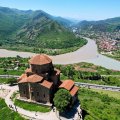DJVARI MONASTERY
This monastery, perched on a mountainside and a UNESCO World Heritage Site, is the holiest site in the whole of Georgia.
The spectacle is grandiose. An eagle's nest clinging to a mountainside, the monastery stands out against the sky and the ochre rock. Built at the end of the foothills of the Lesser Caucasus, controlling the entire valley, this "Monastery of the Holy Cross" (Jvari) occupies a strategic position. It overlooks Mtskheta and the confluence of the Koura and Aragvi rivers. Listed as a UNESCO World Heritage Site, the monastery is the most sacred site in the whole of Georgia. According to the chronicles, after converting King Mirian, Saint Nino planted her vine cross here. She thus put an end to the paganism practiced in the country until then. Christianity became the state religion. The cross is said to have performed miracles, attracting pilgrims from all over the Caucasus. The monument thus marks the birth of Christianity in Georgia. It is an excellent reflection of the skills of medieval builders. Its architectural style influenced the majority of churches built afterwards. Indeed, the monastery served as a prototype for successive generations of architects, not only in Georgia but also in the rest of the Transcaucasus. The same style can be found in Armenia. This one features a cruciform plan for the first time. One branch of the cross has become the apse. The church is organized in a space delineated by corner chapels. The first church was built in 545 by Prince (Eristavi) Gouram (known as the "Little Church of the Cross"); next door, the Great Church was erected by his son Stepanoz between 586 and 605. When Georgia became part of the Soviet bloc, access to the site was forbidden, as it was in a military zone. Since then, the monastery has had a political symbol: that of regained independence.
The site attracts pilgrims from all over the country. Great religious ceremonies still take place here.
The overall effect is one of great harmony between the building and its natural setting. The monastery is not large, but its symbolism far exceeds the simplicity of its appearance. From the doorway, the view of the mountains, the valley below and Mtskheta in the distance is spectacular. The superb lintels overhanging the entrance are said to be of Greek influence. Inside, nothing catches the eye, apart from a large wooden cross standing out against the bare stone.
It's best to hire a cab for a half-day round trip from Tbilisi to visit this monastery and Mtskheta. Alternatively, you can come by marshrutka from Tbilisi or on the way back from West Georgia.
Did you know? This review was written by our professional authors.
Book the Best Activities with Get Your Guide
Members' reviews on DJVARI MONASTERY
The ratings and reviews below reflect the subjective opinions of members and not the opinion of The Little Witty.






A visiter un jour de mariage pour observer les coutumes vestimentaires et religieuses des habitants